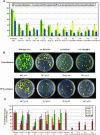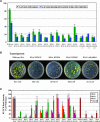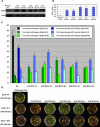Plant proteins that interact with VirB2, the Agrobacterium tumefaciens pilin protein, mediate plant transformation
- PMID: 15494553
- PMCID: PMC527204
- DOI: 10.1105/tpc.104.026476
Plant proteins that interact with VirB2, the Agrobacterium tumefaciens pilin protein, mediate plant transformation
Abstract
Agrobacterium tumefaciens uses a type IV secretion system (T4SS) to transfer T-DNA and virulence proteins to plants. The T4SS is composed of two major structural components: the T-pilus and a membrane-associated complex that is responsible for translocating substrates across both bacterial membranes. VirB2 protein is the major component of the T-pilus. We used the C-terminal-processed portion of VirB2 protein as a bait to screen an Arabidopsis thaliana cDNA library for proteins that interact with VirB2 in yeast. We identified three related plant proteins, VirB2-interacting protein (BTI) 1 (BTI1), BTI2, and BTI3 with unknown functions, and a membrane-associated GTPase, AtRAB8. The three BTI proteins also interacted with VirB2 in vitro. Preincubation of Agrobacterium with GST-BTI1 protein decreased the transformation efficiency of Arabidopsis suspension cells by Agrobacterium. Transgenic BTI and AtRAB8 antisense and RNA interference Arabidopsis plants are less susceptible to transformation by Agrobacterium than are wild-type plants. The level of BTI1 protein is transiently increased immediately after Agrobacterium infection. In addition, overexpression of BTI1 protein in transgenic Arabidopsis results in plants that are hypersusceptible to Agrobacterium-mediated transformation. Confocal microscopic data indicate that GFP-BTI proteins preferentially localize to the periphery of root cells in transgenic Arabidopsis plants, suggesting that BTI proteins may contact the Agrobacterium T-pilus. We propose that the three BTI proteins and AtRAB8 are involved in the initial interaction of Agrobacterium with plant cells.
Figures











Similar articles
-
Arabidopsis RETICULON-LIKE3 (RTNLB3) and RTNLB8 Participate in Agrobacterium-Mediated Plant Transformation.Int J Mol Sci. 2018 Feb 24;19(2):638. doi: 10.3390/ijms19020638. Int J Mol Sci. 2018. PMID: 29495267 Free PMC article.
-
Expression and functional characterization of the Agrobacterium VirB2 amino acid substitution variants in T-pilus biogenesis, virulence, and transient transformation efficiency.PLoS One. 2014 Jun 27;9(6):e101142. doi: 10.1371/journal.pone.0101142. eCollection 2014. PLoS One. 2014. PMID: 24971727 Free PMC article.
-
Arabidopsis RETICULON-LIKE4 (RTNLB4) Protein Participates in Agrobacterium Infection and VirB2 Peptide-Induced Plant Defense Response.Int J Mol Sci. 2020 Mar 3;21(5):1722. doi: 10.3390/ijms21051722. Int J Mol Sci. 2020. PMID: 32138311 Free PMC article.
-
Agrobacterium transformation of Arabidopsis thaliana roots: a quantitative assay.Methods Mol Biol. 2006;343:105-13. doi: 10.1385/1-59745-130-4:105. Methods Mol Biol. 2006. PMID: 16988337 Review.
-
Promiscuous DNA transfer system of Agrobacterium tumefaciens: role of the virB operon in sex pilus assembly and synthesis.Mol Microbiol. 1994 Apr;12(1):17-22. doi: 10.1111/j.1365-2958.1994.tb00990.x. Mol Microbiol. 1994. PMID: 7914664 Review.
Cited by
-
Pathways of DNA Transfer to Plants from Agrobacterium tumefaciens and Related Bacterial Species.Annu Rev Phytopathol. 2019 Aug 25;57:231-251. doi: 10.1146/annurev-phyto-082718-100101. Epub 2019 Jun 21. Annu Rev Phytopathol. 2019. PMID: 31226020 Free PMC article.
-
Agrobacterium-delivered virulence protein VirE2 is trafficked inside host cells via a myosin XI-K-powered ER/actin network.Proc Natl Acad Sci U S A. 2017 Mar 14;114(11):2982-2987. doi: 10.1073/pnas.1612098114. Epub 2017 Feb 27. Proc Natl Acad Sci U S A. 2017. PMID: 28242680 Free PMC article.
-
Agrobacterium-produced and exogenous cytokinin-modulated Agrobacterium-mediated plant transformation.Mol Plant Pathol. 2010 Sep;11(5):677-90. doi: 10.1111/j.1364-3703.2010.00637.x. Mol Plant Pathol. 2010. PMID: 20696005 Free PMC article.
-
Agrobacterium-mediated plant transformation: biology and applications.Arabidopsis Book. 2017 Oct 20;15:e0186. doi: 10.1199/tab.0186. eCollection 2017. Arabidopsis Book. 2017. PMID: 31068763 Free PMC article.
-
Isolation and characterization of the Agvip1 gene and response to abiotic and metal ions stresses in three celery cultivars.Mol Biol Rep. 2014 Sep;41(9):6003-11. doi: 10.1007/s11033-014-3478-x. Epub 2014 Jun 27. Mol Biol Rep. 2014. PMID: 24969482
References
-
- Alonso, J.M., et al. (2003). Genome-wide insertional mutagenesis of Arabidopsis thaliana. Science 301, 653–657. - PubMed
-
- Altschul, S.F., Gish, W., Miller, W., Myers, E.W., and Lipman, D.J. (1990). Basic local alignment search tool. J. Mol. Biol. 215, 403–410. - PubMed
-
- Anthony, K.G., Sherburne, C., Sherburne, R., and Frost, L.S. (1994). The role of the pilus in recipient cell recognition during bacterial conjugation mediated by F-like plasmids. Mol. Microbiol. 13, 939–953. - PubMed
-
- Ausubel, F.M., Brent, R., Kingston, R.E., Moore, D.D., Seidman, J.G., Smith, J.A., and Struhl, K. (2003). Current Protocols in Molecular Biology. (New York: Wiley).
Publication types
MeSH terms
Substances
LinkOut - more resources
Full Text Sources
Other Literature Sources
Molecular Biology Databases
Research Materials

